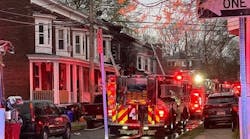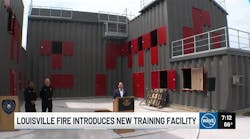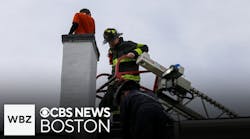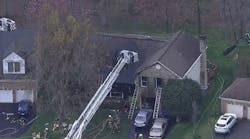White Does Not Necessarily Mean "Hot" - White Means "Warmest"
I received an e-mail recently from a firefighter in a fairly large metropolitan area expressing his concern over what he sees as an apparent misunderstanding among his fellow firefighters as to what exactly "white" means in regard to thermal imaging. According to the firefighter, a truck company performing overhaul entered a residential structure and, after taking a quick look around the room with a thermal imager, determined all the different areas that needed to be removed. When the firefighter questioned the truck company as to how they determined that all of the identified areas needed to be removed, the response he received was, "Well, those are the white areas."
The truck company removed all of the previously identified areas, performed a confirmatory sweep with the thermal imager and, much to their dismay, located many more white spots to be removed. After identifying and removing these newly identified white areas, the truck company performed another sweep and guess what they found - more white areas. Becoming frustrated, the truck officer ordered every wall of the room opened and exposed. Once this was accomplished, clearly showing the fire extension, the thermal imager was still showing white areas.
This frustrating experience underscores a popular misunderstanding when it comes to image interpretation. Many firefighters interpret white to mean "hot." In reality, white means "warmest." At its simplest, a thermal imager is not a heat detector. It simply looks at a particular field of view and indicates the warmest temperatures as white, the coolest temperatures in black and all the temperatures in between as shades of gray. The imager does not really care how warm or cold an object is, simply how much warmer or colder it is than the object next to it.
On a more technical level, let's take a quick look at why this is the case. The heart of any thermal imager is the detector itself or Focal Plane Array (FPA). The FPA of a thermal imager is measured in pixels, which determine resolution. When a thermal imager is being used to evaluate a scene, each individual pixel on the FPA is being exposed to heat. This heat changes the electrical properties of the pixel. It is this change in the individual pixel's electrical properties that gets interpreted as heat.
The raw data generated by the FPA is then processed through any number of image processing algorithms, including automatic gain controls, image equalization, pixel smoothing, gamma tables and others. The result is a black/white display. What all of this technology means is that a thermal imager will always tell you relative heat differences in a given field of view, but it will not indicate "hot" or "cold," only warmer or cooler.
Why is all of this important? It's important because improper image interpretation can lead to serious misunderstandings and potentially tragic consequences. There are two primary mistakes that commonly occur.
Misinterpreting Heat
The truck crew mentioned earlier, on their initial evaluation of the scene, assumed white to be hot. Once these objects were removed and the thermal imager was used a second time, the thermal imager adjusted to find the next hottest object. Appropriately, the thermal imager indicated the next warmest objects in the scene and showed them as white.
Moments ago, these areas were gray because they were in the presence of warmer areas that were indicated as white. What this meant for the truck crew was extra work and extra damage for the homeowner, but in the grand scheme of things, not tragic. Now, let's change the scenario to the smell of something burning at two o'clock in the morning.
You grab your thermal imager and begin to investigate. Standing in the living room of the structure, you examine the outlets on wall number one and wall number three. All the outlets appear to be similar in temperature based on the fact that both are light gray. However, it is summer outside and wall number one is an exterior wall. So wall number one is actually warmer than wall number three, which would make the outlet(s) on wall number one appear artificially cool. This misinterpretation could lead you to miss a fire hazard.
Missed Victims
Take a look at images on page 52. The image on top is a picture of two firefighters that was taken before the fire was started. The firefighters are white as they are the warmest thing in an otherwise ambient scene.
Now look at the second image. These are the same two firefighters during the fire. Now, they did not cool off. In fact, the firefighters got warmer, but appear cold.
Why? Because the ambient temperature changed. The firefighters are not cold, but they are indeed the coolest thing in the field of view. The implications here are that victims may not always appear as white on the thermal imager. They may actually be black, white or any shade of gray. In this case, image misinterpretation can certainly have tragic results if victims are missed during search operations.
Many modern thermal imagers have high-heat colorization, which means that at certain temperature levels, a color gradient is applied to alert the firefighter to areas of excessive heat. Each manufacturer is slightly different regarding how this feature works, but for the purposes of this column, I have intentionally disregarded this feature. If you do not understand your imager's high-heat colorization, please consult your manufacturer to develop an understanding.
We will talk about colorization in another column, but the bottom line is this: Image interpretation is an acquired skill. It must be learned and practiced if it is to be effective. Some of this learning entails an understanding of how the thermal imager works so that we can identify the areas where mistakes are likely to happen. This understanding contributes to more efficient scenes but more importantly, serves to avoid potentially tragic consequences.
Until next time, stay safe.
BRAD HARVEY is the Thermal Imaging Product Manager at Bullard. He is a veteran of public safety as a firefighter, police officer and paramedic and is certified through the Law Enforcement Thermographers' Association (LETA) as a thermal imaging instructor. Harvey has worked as a high-angle rescue instructor and is a certified rescue technician and fire instructor. If you have questions about thermal imaging, you may e-mail him at [email protected].





